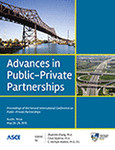Second International Conference on Public-Private Partnerships
Constituent Elements of Feasible Financing Modes for Urban Rapid Rail Transit Projects
Publication: Advances in Public-Private Partnerships
ABSTRACT
The demand for the development of urban rapid rail transit (URRT) is increasing. Traditional financing mode, i.e., government investment for URRT projects, is gradually unable to meet the increasing demand and high cost. More and more innovative financing modes have been applied in recent years, but it is hard for decision makers to compare and select from different financing modes. This paper identifies firstly all feasible financing modes for URRT projects based on theoretical analysis and case studies and then analyzes the constituent elements of each financing mode. Four most common constituent elements including investment entity, operation entity, source of funding, and government support form are extracted, based on which a pool of all financing modes could be constructed, including those supported by related theories, have been applied in major cities all over the world, or proposed by relevant researchers. Furthermore, all financing modes could be expressed in a standardized format highlighting their features and facilitating comparison among various modes. The conclusions provide a more standardized classification of different URRT project financing modes so that decision makers could compare alternative financing modes and make a better decision in a specific project environment more easily and comprehensively.
Get full access to this article
View all available purchase options and get full access to this chapter.
REFERENCES
Akintoye A., Beck M., and Hardcastle C. (2003). Public-private partnerships: managing risks and opportunities. UK: Blackwell Science.
Atkinson A. B. and Stiglitz J. E. (1992). Lectures on public economics. Shanghai: Shanghai Sanlian Press.
Bahl R. W. and Bird R. M. (2008). Tax Policy in Developing Countries: Looking Back and Forward. Tronto: Institute for International Business, Rotman School of Management, University of Toronto. Retrieved from http://www-2.rotman.utoronto.ca/userfiles/iib/File/IIB13(1).pdf
Beijing Infrastructure Investment Co. (2008). Study and demonstration on financing modes of urban rapid rail transit (unpublished report). Beijing, China.
Cai W. (2007). Enlightenment of the basic property of urban rail transit on financing. Urban Mass Transit, 1, 11–13.
Cervero R. and Duncan M. (2001). Rail transit’s value-added: effects of proximity to light and commuter rail transit on commercial land values in Santa Clara County, California. Retrieved from http://citeseerx.ist.psu.edu/viewdoc/download?doi=10.1.1.186.6530&rep=rep1&type=pdf
Chen J. (2011). Theory and application of generalized life cycle cost of urban rail transit project (doctoral dissertation). Beijing Jiaotong University, Beijing, China.
Chinese City Metro Website: http://www.ccmetro.com/information/
Coates D. (1998). Public Sector Crowding Out of Private Provision Public Goods, The Influence of Difference in Production Costs. Public Finance Review, 26(5), 460–479.
Estache A. (1995). Decentralizing infrastructure: advantages and limitations (World Bank Discussing Paper. Report No. WDP 290).
European Commission (2003). Guidelines for successful public-private partnerships. Version 1: 16. Retrieved from http://ec.europa.eu/regional_policy/sources/docgener/guides/ppp_en.pdf
Fang F. (2000). Public choice theory: political economy. Beijing: China Renmin University Press.
Gómez-Ibáñez J. and Meyer J. R. (1993). Going private: The international experience with transport privatization. Washington, DC: The Brookings Institution.
Ke Y. Wang S. Q. Chan A. P. C. and Cheung E. (2009). Research trend of public-private partnership in construction journals. Journal of Construction Engineering and Management, 135(10), 1076–1086.
Keynes J. M. (1988). The General Theory of Employment, Interest, and Money. Beijing: China Commerce and Trade Press.
Kirwan R. M. (1989). Finance for urban public infrastructure. Urban Studies, 26(3), 285–300.
New South Wales Treasury (2006). Working with the government: Guidelines for privately financed projects. Retrieved from http://www.treasury.nsw.gov.au/__data/assets/pdf_file/0009/3141/wwggui_1.pdf
Ostrom V. Schroeder L. and Wynne S. (2000). Institutional incentives and sustainable development: infrastructure policies in perspective. Shanghai: Shanghai Sanlian Press.
Perloff J. (2012). Microeconomics. England: Pearson Education.
Riley D. (2001). Taken for a ride: trains, taxpayers, and the treasury. UK: Center for Land Policy Studies.
Rosenstein-Rodan P. (1961). Notes on the theory of the big push. New York: St. Martin Press.
Schaufelberger J. E. and Wipadapisut, I. (2003). Alternate financing strategies for build-operate-transfer projects. Journal of Construction Engineering and Management, 129(2), 205–213.
Sharkey G. and William W. (1982). The theory of natural monopoly. Cambridge: Cambridge University Press.
Smith A. (1979). An inquiry into the nature and causes of the wealth of nations. Beijing: China Commerce and Trade Press.
Wang S. Q. and Ke Y. (2008). Project financing. Beijing: Tsinghua University Press.
Wang X. (2007). Study on the financing marketization mechanism and mode of urban mass transit infrastructure (master’s thesis). Hehai University. Nanjing, China.
Wang Y. (2011). A study on investment management of Chinese urban rail transit system (doctoral dissertation). Wuhan University of Technology, Wuhan, China.
World Bank (1994). World development report 1994: infrastructure for development. Beijing, China Financial & Economic Publishing House.
Wu W. (2010). Studies on investing and financing way of infrastructure based on theory of project distinction (master’s thesis). Hunan University, Changsha, China.
Ye S. (2011). Study on rewarding system of privately financed urban railway transport projects. Journal of Beijing Jiaotong University (Social Sciences Edition). 10(2), 33–39.
Yescombe E. R. (2007). Public-private partnerships: principles of policy and finance. UK: Butterworth-Heinemann.
Yu W. (2008). Research on rail transportation and its externality (doctoral dissertation). Jilin University, Jilin, China.
Zhang H. Liu Y. and Dong S. (2007). Experiences of investment/financing on metro in seven world cities. Urban Mass Transit, 10, 6–10.
Zheng S. (2007). Research on the private provision of quasi-public goods and the role of government (doctoral dissertation). Liaoning University, Liaoning, China.
Information & Authors
Information
Published In
Advances in Public-Private Partnerships
Pages: 14 - 26
Editors: Zhanmin Zhang, Ph.D., The University of Texas at Austin, Cesar Queiroz, Ph.D., N/A, and C. Michael Walton, Ph.D., The University of Texas at Austin
ISBN (Online): 978-0-7844-8026-7
Copyright
© 2016 American Society of Civil Engineers.
History
Published online: Jul 11, 2017
Authors
Metrics & Citations
Metrics
Citations
Download citation
If you have the appropriate software installed, you can download article citation data to the citation manager of your choice. Simply select your manager software from the list below and click Download.
